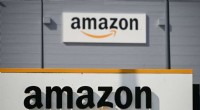Silicon Valleys teknologiske monopol er forbi. Er fremtiden i Austin, Texas?

Kredit:Pixabay/CC0 Public Domain
Da Tesla sidste efterår annoncerede, at de flyttede sit hovedkvarter fra Californien til Texas, virkede embedsmænd i Sacramento mere overraskede end bekymrede.
Tesla udvidede trods alt sit vidtstrakte samleanlæg i Fremont, Californien, som allerede beskæftiger tusindvis af mennesker. Det er ved at bygge en batterifabrik i byen Lathrop i det nordlige Californien.
Og ejendomsmæglere siger, at virksomheden lejer mere kontorplads i Palo Alto, Californien, hvor dets hovedkvarter havde været placeret siden 2009. Tesla blev grundlagt i det nærliggende San Carlos i 2003.
Alligevel kan Musks beslutning om at flytte elbil-pionerens hovedkvarter til Texas delstatshovedstad Austin signalere, at skyer samler sig i horisonten af Californiens økonomiske fremtid.
For øjeblikket ser det stadig lyst ud for staten. Sacramento har nydt en hidtil uset vækst i indtægterne, i høj grad takket være høje kapitalgevinstskatter betalt af de superrige i Silicon Valley.
Og i et mål af Californiens nuværende greb om teknologisektoren, er Golden State stadig langt fra førende inden for at rejse venturekapital.
I årevis har Californien lidt af en nettoudvandring af mennesker til Texas. Men tabene i befolkning havde en tendens til at være i den lavere ende af den socioøkonomiske skala, og staten er blevet støt rigere på trods af den store udstrømning af mennesker.
Det, der bekymrer nogle økonomer og andre analytikere, er, at dette gunstige mønster kan begynde at ændre sig.
Tesla var en af et accelererende antal californiske virksomheder, herunder andre store teknologinavne som Oracle og HP Enterprise, der har flyttet hovedkvarteret til Texas.
"Jeg tror, at dette kun er toppen af isbjerget," sagde Dan Ives, der har dækket tech-sektoren i mere end to årtier og i øjeblikket er administrerende direktør hos Los Angeles-baserede Wedbush Securities. Han sagde, at 20 % af de virksomheder, han følger, overvejer at flytte eller åbne et andet hovedkvarter uden for Californien.
Stanfords Hoover Institution talte 74 sådanne virksomheder, der flyttede ud af staten i første halvdel af sidste år, mere end hele 2020 og højere end den sammenlignelige periode i hvert af de foregående to år. Forskere citerede en række faktorer for ændringen:De stigende leveomkostninger i Californien, en skattestruktur og arbejdsmarkedspolitikker, som mange virksomhedsledere ser som uvenlige, og bekymring for, at livskvaliteten er faldende.
I tilfældet med Tesla, som i sidste måned også begyndte at producere køretøjer i nærheden af Austin, kan de decideret konservative synspunkter fra dens multimilliardærchef have gjort Texas til en tiltalende base. Musk flyttede personligt dertil i 2020.
Statens nettobefolkningstab til Texas, den største destination for migranter, var sidste år omkring det dobbelte af det sidste årti, ifølge kreditdata analyseret af Moody's Analytics. Nogle beholdt deres californiske job takket være nye fjernarbejdsmuligheder. Andre startede nye virksomheder i Texas.
Det er helt sikkert, at Bay Area har et så dybt reservoir af teknologisk talent, penge og infrastruktur, for ikke at nævne klimaet og havet, at det ikke nemt vil blive slået ud af siddepladsen.
Førstegenerationsteknologivirksomhederne Apple, Cisco, Intel, Hewlett-Packard, blandt andre, er stadig i Bay Area, ligesom nyere teknologiikoner Facebook, Google og Netflix.
Og Stanford og Berkeley er nøglegeneratorer af talent, forskning og nye ideer til Silicon Valleys økosystem.
Men Californiens teknologiske centrum i dag ser ud til at stå over for det, der ramte Hollywood år tidligere, hvor Canada og stater som Georgia, hvor Marvel laver meget af sine optagelser i dag, lokkede filmproduktion væk fra Los Angeles med adskillige incitamenter.
"The Silicon Valley has lost its monopoly on opportunity, and now it has to compete," said Patrick McKenna, founder of One America Works, which connects talent with new tech communities. "It has to compete with other locations to attract the talent that's going to build the future."
McKenna spent 15 years in the Bay Area as an entrepreneur and investor, but in 2019 moved to Austin. He saw opportunities in central Texas, but also rued the fact that many people in the Bay Area were getting left behind in the tech boom.
Of the state's record budget surpluses, McKenna said, "California is flush right now because it's harvesting an investment that happened 10 years ago."
Increasingly he sees other states and nations cutting into California's share of the technology industry.
Economic officials at California Gov. Gavin Newsom's office say it's natural that as companies such as Tesla grow to become world leaders, they will expand elsewhere to be closer to markets and supply chains and to extend their global footprint.
Businesses will continue to leave California just as they have for decades, these officials argue, but there are good reasons why firms were born and incubated in the state, and why more will come and start new ventures and take companies public, creating more wealth and more jobs.
"The idea that the California economy is imperiled is not borne out by the numbers," said Dee Dee Myers, a former White House press secretary for President Clinton. She is now Newsom's director of business and economic development.
It's true that in tech, no city or state comes close to the Bay Area in the amount of new venture capital—$120 billion last year, a figure that until 2018 was more than the rest of the country combined, said Kyle Stanford, a senior analyst at PitchBook, a Seattle-based financial data and software firm that tracks private capital markets.
In terms of number of venture capital deals, despite growth elsewhere, the Bay Area's share held firm last year—topping 20% as it has every year since at least 2006. That's important because companies tend to start or set up fairly close to where the lead investor is based, which buys the Bay Area some time.
But, Stanford says, "There's definitely a risk of losing major emerging companies when you have these large tech giants move out. You're going to see engineers from Tesla probably create new companies in Austin, and those are companies that are going be lost in the Bay Area."
Moreover, while in the popular imagination Texas remains a vast landscape of cowboys, oil and conservative politics, the reality is more complex:The state's universities have built up stronger reputations in engineering and other specialties prized by corporations.
And Austin, whose unofficial motto is "Keep Austin weird," demonstrates at least some parts of the state are becoming culturally compatible with Californians.
Nor can Silicon Valley count on people coming from overseas to make up the loss.
Foreign-born students, researchers and entrepreneurs have been a big part of California's tech boom, but the unwelcoming immigration policies under former President Trump, plus lingering effects of the COVID-19 pandemic, and cold-war-like relations with China, have had chilling effects.
Then there's California's high cost of living, particularly housing.
In the Bay Area, the typical home now fetches a median price of $1.2 million, which is more than double the cost in Austin, despite the rapid rise in home values there. The cost of housing in Dallas is one-fourth the price in the Bay Area.
Brett Arnold, 35, an accountant and lifelong California resident, and his wife, Jamie, moved to a town about an hour north of Dallas last July, primarily because of the difference in the cost of living.
The couple had both worked in Orange County to keep up financially, but she wanted to stay at home with their 4-year-old. So last April the Arnolds sold their Rancho Santa Margarita townhome for $730,000 and bought a much larger 2,800-square-foot house in Prosper, Texas, for $570,000.
"The quality of life has gone up," Brett Arnold said.
For now at least, Austin's share of the nation's venture capital, tech startups and revenues pales next to the Bay Area. But it is rising, thanks in good part to Silicon Valley.
Meta, formerly Facebook, is leasing 33 floors in what will soon be the city's tallest building. Oracle is estimated to have 2,500 employees currently at its campus near Lady Bird Lake, and local reports say it's buying nine more acres nearby, enough to house well over 10,000 workers.
Amid the pandemic in 2020, as Oracle announced its headquarters move, the company said it would take "a modern approach to work that gives our employees more flexibility to choose where and how to work."
No one knows how many from Tesla have moved with Musk, although some, including Valerie Workman, head of human resources and one of its highest-ranking Black employees, have since left the company.
Musk, in his characteristically flamboyant style, said its Texas operations could scale up to 20,000 employees. Its Austin-area factory has the potential to produce three times as many vehicles as the Fremont facility, said Ives of Wedbush.
Over the next 18 to 24 months, Ives said, Tesla is likely to move the R&D and design operations now in Palo Alto to Austin.
"They could find engineers 50% cheaper in Austin than in the Silicon Valley," he said. And such a move would bring the company's brain trust close to where Musk himself lives.
Plus, that's what many employees may prefer, to settle in semi-remote places where they can enjoy a higher standard of living. It's partly why Tesla's Irvine-based rival, Rivian, is producing its vehicles in northern Illinois and outside Atlanta, analysts say.
Intel is building its new chip factory in Columbus, Ohio. Other tech firms are going to Nashville.
"California and the Valley always will have an allure geographically that can't be matched," Ives said, "but now you're starting to see alternatives."
Joel Kotkin, a fellow at Chapman University and longtime analyst of demographic, social and economic trends in California, worries especially about the state's heavy dependence for tax dollars from tech IPOs and the super-wealthy to pay for progressive but expensive policies—such as for the environment and the social safety net.
In 2019, the top 1% of taxpayers in California paid about 45% of personal income taxes, which make up about two-thirds of the state's entire general fund revenues.
In a report with colleague Marshall Toplansky, Kotkin wrote that the losses of company headquarters have eroded the state's economic diversity and opportunities for upward mobility for the middle class.
"In the aggregate we could look good because Apple computer by itself makes you look good," Kotkin said in an interview. "If we continue this gusher of tech money, we could just continue to subsidize the vast majority of the population and maybe won't collapse," he said.
But what happens if that cornucopia of tax money begins to shrink?
"We could either restore California's promise as a land where people go and their lives are improved," he said, "or we could become some sort of high-tech feudal state, which is where we're headed."
 Varme artikler
Varme artikler
-
 British Airways piloter accepterer lønaftale for at afslutte strejkerBritish Airways piloter holdt en walkout i september for første gang i flyselskabets historie Piloter fra fagforeningen BALPA accepterede mandag en lønaftale med flagskibsselskabet British Airways
British Airways piloter accepterer lønaftale for at afslutte strejkerBritish Airways piloter holdt en walkout i september for første gang i flyselskabets historie Piloter fra fagforeningen BALPA accepterede mandag en lønaftale med flagskibsselskabet British Airways -
 Politiet holder øje med dine opslag på sociale medier. Krænkelse af privatlivets fred eller fair …Kredit:Pixabay/CC0 Public Domain Siden platformen MySpace blev lanceret i 2003, har politiet overvåget sociale medier, der søger efter mistænkte og forsøger at forudsige kriminalitetstendenser, hvi
Politiet holder øje med dine opslag på sociale medier. Krænkelse af privatlivets fred eller fair …Kredit:Pixabay/CC0 Public Domain Siden platformen MySpace blev lanceret i 2003, har politiet overvåget sociale medier, der søger efter mistænkte og forsøger at forudsige kriminalitetstendenser, hvi -
 Amazon-arbejdergruppe opfordrer til strejke på grund af virus- og klimaproblemerE-handelskolossen menes at have haft COVID-19-tilfælde i en række af sine lagre Amazons teknologiarbejdere opfordrer til en virtuel endagsstrejke for at presse online-detailgiganten over lagersikk
Amazon-arbejdergruppe opfordrer til strejke på grund af virus- og klimaproblemerE-handelskolossen menes at have haft COVID-19-tilfælde i en række af sine lagre Amazons teknologiarbejdere opfordrer til en virtuel endagsstrejke for at presse online-detailgiganten over lagersikk -
 Ny rekord for krakning af krypteringsnøglerKredit:CC0 Public Domain Et internationalt team af computerforskere havde sat en ny rekord for to af de vigtigste beregningsproblemer, der er grundlaget for næsten hele den public-key kryptografi,
Ny rekord for krakning af krypteringsnøglerKredit:CC0 Public Domain Et internationalt team af computerforskere havde sat en ny rekord for to af de vigtigste beregningsproblemer, der er grundlaget for næsten hele den public-key kryptografi,
- Mikrofluidisk chip kan reducere bivirkninger ved strålebehandling
- Første offentliggjorte resultater fra ny røntgenlaser
- Eksisterende laserteknologi kunne omdannes til Jordens verandalys for at tiltrække fremmede astrono…
- Lille bitte, lysfølsomme chips kunne en dag genoprette synet for blinde
- Firefox Reality browser plus Oculus Quest er prom konge og dronning
- Greenpeace siger, at canadisk skovbrugssag har til formål at bringe kritikere til tavshed


